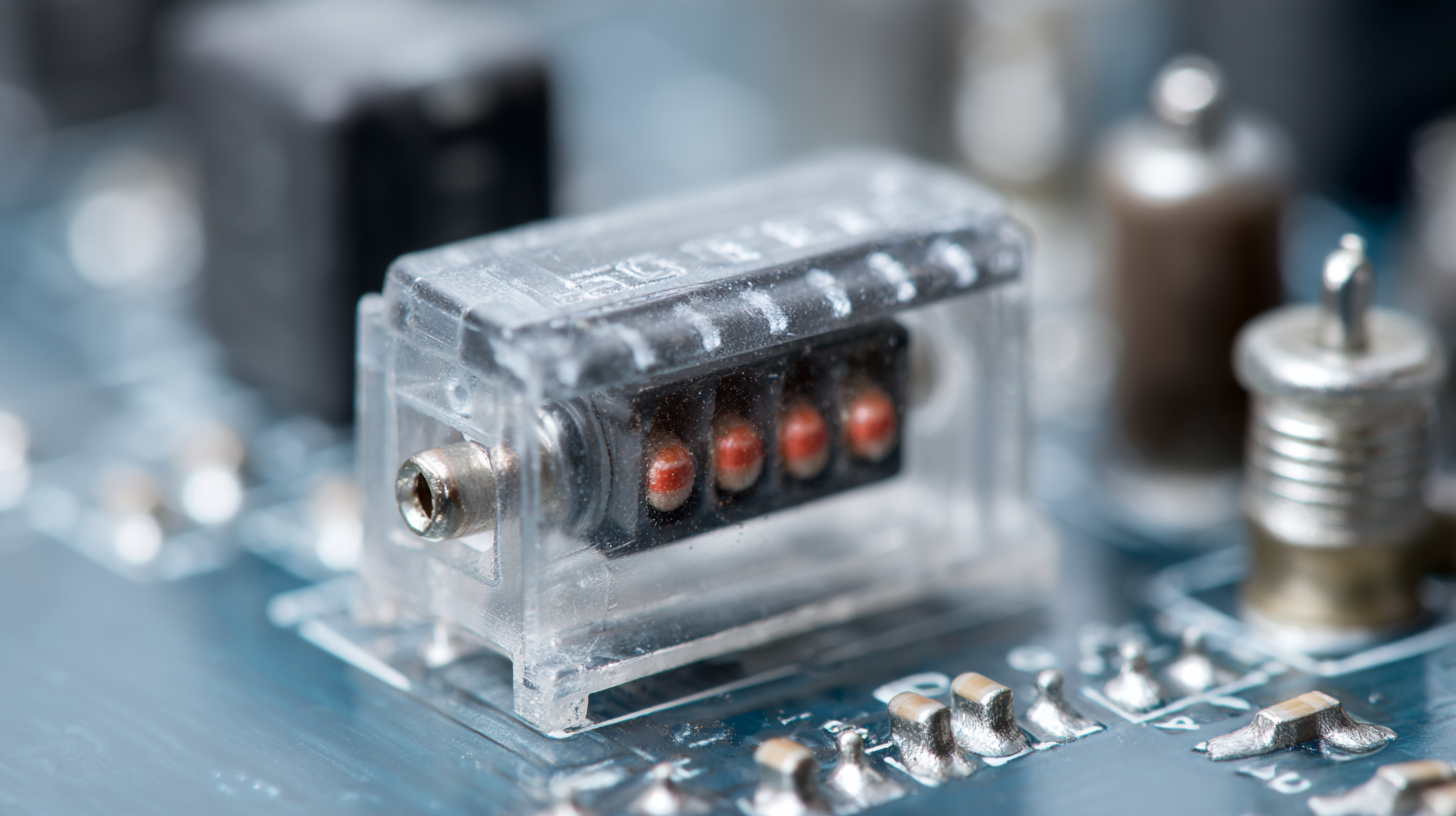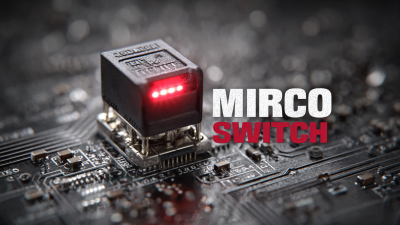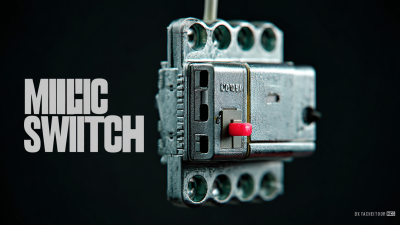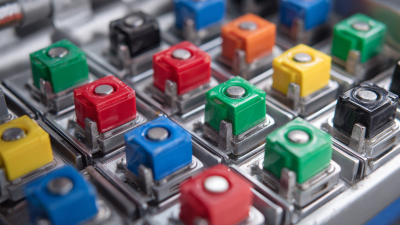Exploring the Role of Micro Switch Buttons in Modern Electrical Devices
In the ever-evolving landscape of modern electrical devices, the Micro Switch Button has emerged as a pivotal component, crucial for enhancing functionality and user experience. According to a recent report by the Market Research Future, the global micro switch market is projected to reach USD 1.2 billion by 2025, growing at a CAGR of 7.5% from 2019 to 2025. This growth is driven by the increasing demand for reliable and efficient control mechanisms in appliances ranging from home automation systems to automotive applications.

Micro Switch Buttons offer superior performance through their compact design and high precision, ensuring responsiveness and durability in applications where even the slightest malfunction can lead to significant operational failures. As industries push for smarter electronics, understanding the intricacies of Micro Switch Buttons will be essential for engineers and developers aiming to harness their full potential in designing advanced electrical devices.
Understanding Micro Switch Buttons: Features and Functionality
Micro switch buttons are essential components in many modern electrical devices, providing critical functionality in a compact form. These small switches operate based on mechanical movements and are designed to offer a reliable and responsive action. Typically characterized by their quick response times and tactile feedback, micro switches are widely utilized in various applications ranging from household appliances to industrial machinery. Their ability to operate with minimal force makes them ideal for scenarios where user interface and ease of use are paramount.
In addition to their physical properties, micro switch buttons come with various features that enhance their functionality. Many are designed to withstand high cycles of operation, ensuring longevity and durability even under rigorous conditions. Furthermore, they can be engineered to meet specific requirements, such as resistance to dust and moisture, making them suitable for both indoor and outdoor uses. The versatility in design and functionality allows micro switch buttons to cater to diverse needs, contributing significantly to the efficiency of modern electrical devices.

The Importance of Micro Switches in Modern Electrical Appliances
 Micro switches play a crucial role in the functionality of modern electrical appliances. These small yet powerful switches are designed to operate at the slightest touch, providing reliability and precision in a wide range of devices. From household items like refrigerators and microwaves to complex machinery in industrial settings, micro switches ensure that devices respond accurately and efficiently. Their design allows them to handle various loads, making them suitable for both low and high-power applications.
Micro switches play a crucial role in the functionality of modern electrical appliances. These small yet powerful switches are designed to operate at the slightest touch, providing reliability and precision in a wide range of devices. From household items like refrigerators and microwaves to complex machinery in industrial settings, micro switches ensure that devices respond accurately and efficiently. Their design allows them to handle various loads, making them suitable for both low and high-power applications.
The importance of micro switches extends beyond mere functionality. They enhance user experience by enabling instant response and control over appliances. For instance, in a washing machine, a micro switch can detect the lid's position to prevent operation when open, ensuring safety. Additionally, their compact size allows for more streamlined designs in devices, contributing to the minimalist aesthetics favored in contemporary technology. In essence, micro switches are integral to the performance, safety, and user-friendliness of modern electrical appliances, reflecting their indispensable role in today’s technological landscape.
Step-by-Step Guide to Selecting the Right Micro Switch Button
When selecting the right micro switch button for your electrical device, it's essential to consider several factors that will ensure optimal functionality. First and foremost, assess the application requirements. Micro switches can operate in various environments, so understanding the voltage and current ratings specific to your device is crucial. Ensure that the button can handle the electrical load it will encounter to avoid failure.
Next, evaluate the mechanical characteristics of the micro switch buttons. This includes the actuation force, travel distance, and life cycle ratings. Depending on how often the switch will be used, choosing a button with a suitable life cycle rating can prevent premature wear and enhance reliability. Additionally, consider the type of actuation—whether you need a brief, tactile response or a more prolonged engagement could significantly influence your choice.
Lastly, don’t overlook the physical dimensions and mounting options. Ensure that the micro switch fits comfortably within the designated space in your device. Choosing products with various mounting configurations can simplify integration and optimize the overall design. By carefully considering these factors, you can effectively select a micro switch button that meets your device's needs while ensuring durability and performance.
Troubleshooting Common Issues with Micro Switch Buttons
Micro switch buttons play a crucial role in modern electrical devices by providing reliable control and feedback on various operations. However, like any component, they can face issues that hinder their performance. Common problems include stickiness, failure to activate, and intermittent response. These issues can stem from wear and tear, dust accumulation, or electrical problems.
To troubleshoot these complications, it's essential to start with a thorough inspection. Make sure the micro switch is clean and free of debris. A can of compressed air can effectively remove any dust particles, while isopropyl alcohol can be used to clean the contacts if they're sticky. Additionally, check the wiring connections to ensure there's no damage or loose connections that could be causing the malfunction.
**Tips:** Always avoid using excessive force when operating micro switches, as this can lead to premature wear. Regular maintenance, including periodic cleanings and visual inspections, can significantly extend the lifespan of these components. If issues persist, it may be time to replace the switch to restore optimal functionality.
Exploring the Role of Micro Switch Buttons in Modern Electrical Devices - Troubleshooting Common Issues with Micro Switch Buttons
| Device Type | Micro Switch Button Function | Common Issues | Troubleshooting Tips |
|---|---|---|---|
| Home Appliances | Power Control | Button Sticking | Clean the switch, check for debris |
| Industrial Equipment | Safety Interlock | Inconsistent Response | Inspect wiring connections, replace switch if necessary |
| Gaming Consoles | User Input | No Response | Check for internal damage, clean contacts |
| Medical Devices | Function Control | False Activation | Test sensitivity settings, recalibrate |
| Automotive Systems | Safety Mechanism | Electrical Failures | Check fuses, inspect for corrosion |
Innovative Applications of Micro Switches in Emerging Technologies
Micro switches, though small in stature, play a colossal role in the functionality of modern electrical devices. Their rapid response times and reliability make them indispensable in various innovative applications across emerging technologies. According to a report by MarketsandMarkets, the global micro switch market is projected to reach
$2.2 billion by 2026, fueled by its increasing adoption in sectors such as automotive, healthcare, and consumer electronics. This surge is largely attributed to the growing demand for automation and smart technology solutions.
One striking application of micro switches can be seen in the field of robotics, where precision is crucial. In robotic arms, they ensure accurate positioning and control, enhancing operational efficiency. Similarly, the automotive industry utilizes micro switches in safety systems, such as
seatbelt reminders and anti-lock brake systems, ensuring that safety protocols are met effectively. According to a study by ResearchAndMarkets, the integration of micro switches in vehicles is projected to increase by
15% annually as more manufacturers emphasize advanced safety features.
Tips: When designing with micro switches, consider their durability ratings and required actuation force to ensure optimal performance in your specific application. Additionally, integrating micro switches into safety-critical systems requires rigorous testing to maintain compliance with industry standards.
Related Posts
-

Setting the Benchmark for Best Micro Switch On Off with Industry Standards
-

How to Choose the Best Micro Switch for Your Industrial Automation Needs: A Comprehensive Guide
-

2025 Industry Insights: Ultimate Checklist for Selecting the Best Micro Switch Push Buttons
-

The Future of Mouse Micro Switch Technology in Enhancing User Experience and Device Performance
-

Your Essential Guide to Micro Limit Switches: Choosing the Right One for Your Application
-

The Future of Advanced Waterproof Rocker Switch Technology

